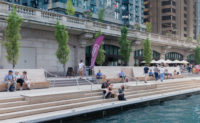 |
| Image courtesy Lucas Museum of Narrative Art |
| After a proposed Lucas museum, with a banal Beaux Arts design, was rejected for the Presidio in San Francisco, the filmmaker brought an edgy new 400,000-square-foot scheme by MAD Architects to Chicago—nearly four times the size of his original plan. |
The avant-garde's defense of the mountainous blob that Star Wars creator George Lucas wants to erect on Chicago's lakefront speaks volumes about all that's wrong with architecture today: a celebration of object-making at the expense of public space, plus a shameless coddling of the powerful, provided they serve one's aesthetic agenda. The defenders of the proposed Lucas museum, who include Frank Gehry and critic Michael Sorkin, still want to party like the recession never hit. Superrich clients! Icons! The Bilbao effect!
They need to sober up.
The field for this battle is Chicago's greatest public space, a nearly 30-mile-long chain of parks and beaches along Lake Michigan. Outsiders often fail to grasp the complementary contrast between the lakefront and the Loop. The shoreline is both a forecourt for Chicago's man-made topography of skyscraper cliffs and canyons, and a realm unto itself. Chicagoans prize the sacrosanct front yard for its open spaces and a sweeping horizontal gestalt that encompasses the lake as well as the land and buildings that rim it.
For more than a century, visionaries like mail-order mogul A. Montgomery Ward have fought to preserve the lakefront from well-meaning incursions that would forever compromise its character. MAD Architects' design for the $300 million Lucas Museum of Narrative Art—unveiled last November and planned to house an eclectic collection of Realist paintings, “Star Wars” memorabilia, and digital art—is simply the latest would-be invader. At a projected 400,000 square feet, it's a needlessly massive intruder—four times the size of the banal Beaux Arts museum Lucas originally proposed for San Francisco's Presidio. When those plans were rejected, Chicago Mayor Rahm Emanuel lured Lucas to the prime Chicago lakefront site.
That the 17-acre site consists of a two-level parking deck and a surface parking lot makes the choice seem easy. Why not put a museum there? But things look dramatically different when you widen the lens and see that the parking is sandwiched between a massive Miesian convention hall (McCormick Place's Lakeside Center) and a Klingon-meets-Parthenon football stadium (Soldier Field). Cramming yet another building between these alien objects would push this already overburdened stretch of lakefront past the tipping point, fouling it with new levels of crowding and congestion. It would be far better to convert the parking into parkland.
In January's RECORD, Sorkin ignores this issue and many others. He doesn't address how the museum's nearly windowless, Jabba the Hutt–like mass would block views of Lake Michigan from Lake Shore Drive. Nor does he note the irony of a building along Lake Michigan that would largely prevent people inside it from seeing the lake. And the famously skeptical critic takes Lucas's claims at face value, asserting that MAD's site plan “will allow green space to flow around the museum.” Really? The plan provided little or no new parkland.
Worse is Sorkin's apologia for the autocratic process that led to the lakefront site: “It was proposed by a well-composed committee with no particular axes to grind,” he claims. But the story of the Emanuel-appointed committee was hardly an exercise out of a civics textbook. Lucas wound up hiring a committee member, architect Jeanne Gang, to design the museum's landscape—a classic inside job. The public hearings are happening only now—after the site selection is a fait accompli. Sorkin's usual sense of righteous indignation took a backseat to his avant-gardism.
As I've suggested, the museum should be built a few miles to the south, atop a deck envisioned for a convention-center truck yard. There, west of Lake Shore Drive, MAD Architects' mountain would still command lake views but would not crowd the shoreline —and it would boost the nearby historic African-American neighborhood of Bronzeville. Open-space advocates, who are fighting Lucas's plan in court, like the idea, but Emanuel has ignored it.
As for the design itself, even the mayor is holding it at arm's length, terming it “bold” but also merely “conceptual” and “part of an overall process.” Gehry, for his part, argued in a November Chicago Tribune op-ed that radical architectural experiments deserve a chance to evolve.
But why not rethink the design altogether, making the museum the equivalent of a low-slung dune, not an overwhelming mountain? A horizontally massed Lucas museum, with parkland on its roof and parking placed underground, could be integrated with the lakefront, not just a domineering object plopped onto it.
Architecture matters, to be sure, yet the character of a public space matters far more. Too bad for Chicago's lakefront—and for architecture as a whole—that the defenders of Lucas's Darth Invader design don't get that and cling to an outdated, icon-centric model of urban design.
RECORD Chicago Tribune.


Post a comment to this article
Report Abusive Comment